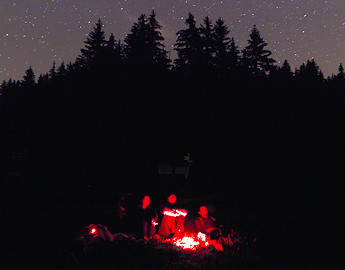Hi everyone,
TL;DR: I’m trying to process the image below, shot close to the limit of what poor old 550D could do, and have a lot of questions about it 
IMG_6004.CR2 (29.4 MB) (Licensed under CC BY-SA 4.0)
I’m well aware the conditions are not ideal (and I should have gotten a dark frame or two while shooting!), but for the sake of experimenting I’d like to see how far I can go.
My most successful attempt was to minimize exposure adjustments so that the noise is not too visible, which gives my best result so far:
IMG_6004_05.CR2.xmp (14.0 KB)
In another attempt, I tried to push the exposure a bit more to see what I could do and gave it a more “cartoony look”. Pushing saturation a bit too far for visibility (ugh!):

IMG_6004_04.CR2.xmp (25.4 KB)
When exported at low resolution (the above is actually a screenshot of the Darktable editing window at very low zoom), you can clearly see color in the grass ; however it’s completely drowned out in the noise in the final exported picture, and is no longer visible when the exported JPEG is viewed later, at any resolution:
Most notably, and this brings me to my main point, the lowres preview is clearly different from the fullres exported image.
I would be perfectly happy to trade off a lower resolution with a little more colors and less noise. In this case it makes no sense to run a full demosaicing, so I could even bin Bayer pixels together to get great noise reduction for “free” and potentially get rid of some of that annoying pattern noise.
Technically I can get similar results to the preview by telling the export module to limit the output resolution, but:
- Where does the resolution change happen in the pipe if I do this? Before/after Demosaic?
- Is there somewhere a rescale operator that I can insert in the pipeline just for this image so I don’t have to change the settings globally in the Export module?
- Can I tell the Demosaic module to not do any fancy algorithm, just bin pixels to reduce noise?
- Do you have any tips regarding how to process this image?
On a side note, I tried to add an option in the Demosaicing module and got “some” results ; by which I mean that I can currently get a lower-resolution output if I select my custom “binning” algorithm (great!) but wrong clip coordinates (duh…).
This is my first time trying out Darktable’s source code, so I am still a little unsure about how a crop is defined using dt_iop_roi_t, and how to make the Demosaicing module change the resolution in the middle of the pipeline. Any pointers on where to start?
That’s it, if you’re still there, thanks for having listened to my ramblings 






